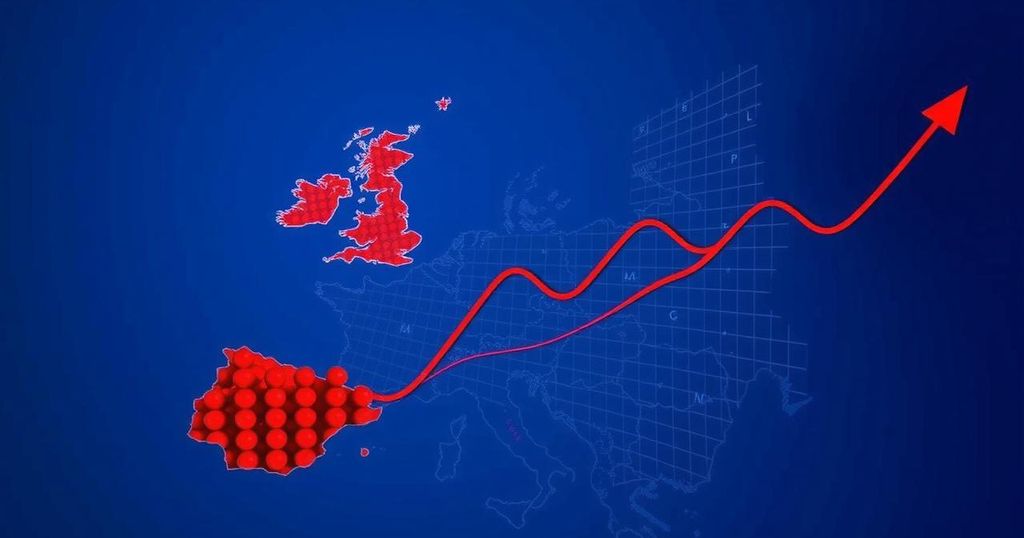Original Source: www.boursorama.com
The article discusses the current precarious state of European and global markets in light of recent trade developments initiated by Donald Trump’s administration. With fears surrounding new tariffs and economic indicators looming, traders are on high alert, evaluating their positions in response to shifting policies. This intricate dance of economic signals showcases the interconnectedness of global markets and the impact of political decisions on investor sentiment. Key focus points include the appointment of Jamieson Greer to a US trade representative role, economic indicators from both Europe and the US, and the performance of various indices in Asia, alongside shifts in currency values and bond yields.
As the sun sets over the bustling financial districts of Europe, shadows of uncertainty loom larger. Wednesday dawns with predictions of a downturn in major European stock markets, triggered by the recent appointment of Jamieson Greer as the new American trade representative. His involvement in the previous trade wars has reignited fears of fresh tariffs, sending ripples through investor sentiment as numerous economic indicators are set to be released throughout the day.
Futures contracts hint at a decline of 0.33% for Paris’s CAC 40, while London’s FTSE could see a modest rise of 0.1%. In Germany, the DAX remains anchored in stability, and the EuroStoxx 50 teeters down by 0.17%. With Donald Trump’s administration poised to adopt a hardened stance on trade, concerns mount. The strategic minds at Rabobank have noted that recent actions against Canada and Mexico have prompted traders to rethink their strategies, now bracing for a potentially aggressive trade environment.
Trump’s firm commitment to impose tariffs could shake the foundations of trade relationships, particularly with Canada, Mexico, and China. Meanwhile, economic uncertainty continues to be underscored by key indicators: Germany’s consumer confidence index for December is expected to remain low, reflecting ongoing political unease ahead of imminent elections. Over in the United States, Third Quarter GDP figures and October’s inflation rate will shed light on the economy’s vitality.
As traders and analysts peel back the layers of the recently released Federal Reserve’s meeting notes, they encounter a division among policymakers on the pace and extent of future interest rate cuts. Meanwhile, the U.S. markets pause for Thanksgiving, anticipating a much-needed respite.
Across the Atlantic, Wall Street posted gains, buoyed by tech stocks amid a relatively sanguine reaction to Trump’s anticipated tariff increases. The indices bore witness to a noticeable uptick with the Dow Jones rising by 123.74 points.
In the eastern skies, Japan’s markets falter under the weight of a stronger yen and the repercussions of Trump’s announcements, causing a 0.8% dip in the Nikkei index. Automotive stocks felt the hit particularly hard, with global export pressures fostering an air of caution among investors.
China, however, saw a silver lining as industrial profit declines slowed, lifting its markets into positive territory with the Hang Seng and Shanghai indices both enjoying solid gains. The contrasting fortunes exemplify the precarious balance of global economics amidst these political upheavals.
Bond yields in the U.S. show little movement ahead of a sequence of economic data releases, while in Europe, the gap between the French OAT and the German Bund widens, touching levels unseen since 2012. This growing divide raises eyebrows concerning the sustainability of France’s public debt, generating an undercurrent of tension in financial circles.
In currency markets, the yen’s ascent as a safe haven reflects traders’ jitters regarding potential trade fallout. Only time will tell whether these swirling currents of change lead to calmer seas or tumultuous storms, but for now, the world watches closely as markets breathe in sync with the evolving saga of international trade.




